Hledáte lehké lyže do terénu, které jsou snadno použitelné a nezruinují vás? Tady je to podstatné: kratší, lehčí lyže ovládnou rok 2025 a zpřístupní lyžování v terénu jako nikdy předtím. Zapomeňte na těžké vybavení nebo drahé specializované boty – kompaktní designy jako Snowfeet WALKSKI vám umožní snadno vyrazit na stezky.
Tady je rychlý přehled:
- Snowfeet WALKSKI (100 cm): Za pouhých 299–349 USD jsou tyto lyže lehké (2,6 libry každá), skladné a fungují s běžnou zimní obuví. Ideální pro zvlněný terén, lesní stezky a nenáročná dobrodružství.
- Blizzard Zero G 105: Skvělý pro hluboký prašan a strmé svahy, ale vyžaduje alpine touring (AT) boty a vázání. Cena: 600–800+ USD.
- Black Diamond Helio Carbon 95: Vysoce výkonný pro technický terén, ale těžší a dražší (700–900+ USD).
- K2 Wayback 106: Spolehlivý, ale vyžaduje další vybavení s AT botami a vázáním. Cena: 500–700+ USD.
- Salomon QST Echo 106: Lehký a všestranný pro mírný terén, ale stojí 550–750+ USD s specializovaným vybavením.
Jádro věci? Pokud jste začátečník nebo rekreační lyžař, Snowfeet WALKSKI je jednoduchá a cenově dostupná volba. Pokročilí lyžaři, kteří se pouštějí do strmého nebo prašanového terénu, mohou preferovat tradiční vybavení, ale pro většinu objevitelů divočiny WALKSKI usnadňuje začít bez komplikací.
Porovnání alpských turistických lyží 2025 80-112 mm se SkiEssentials.com
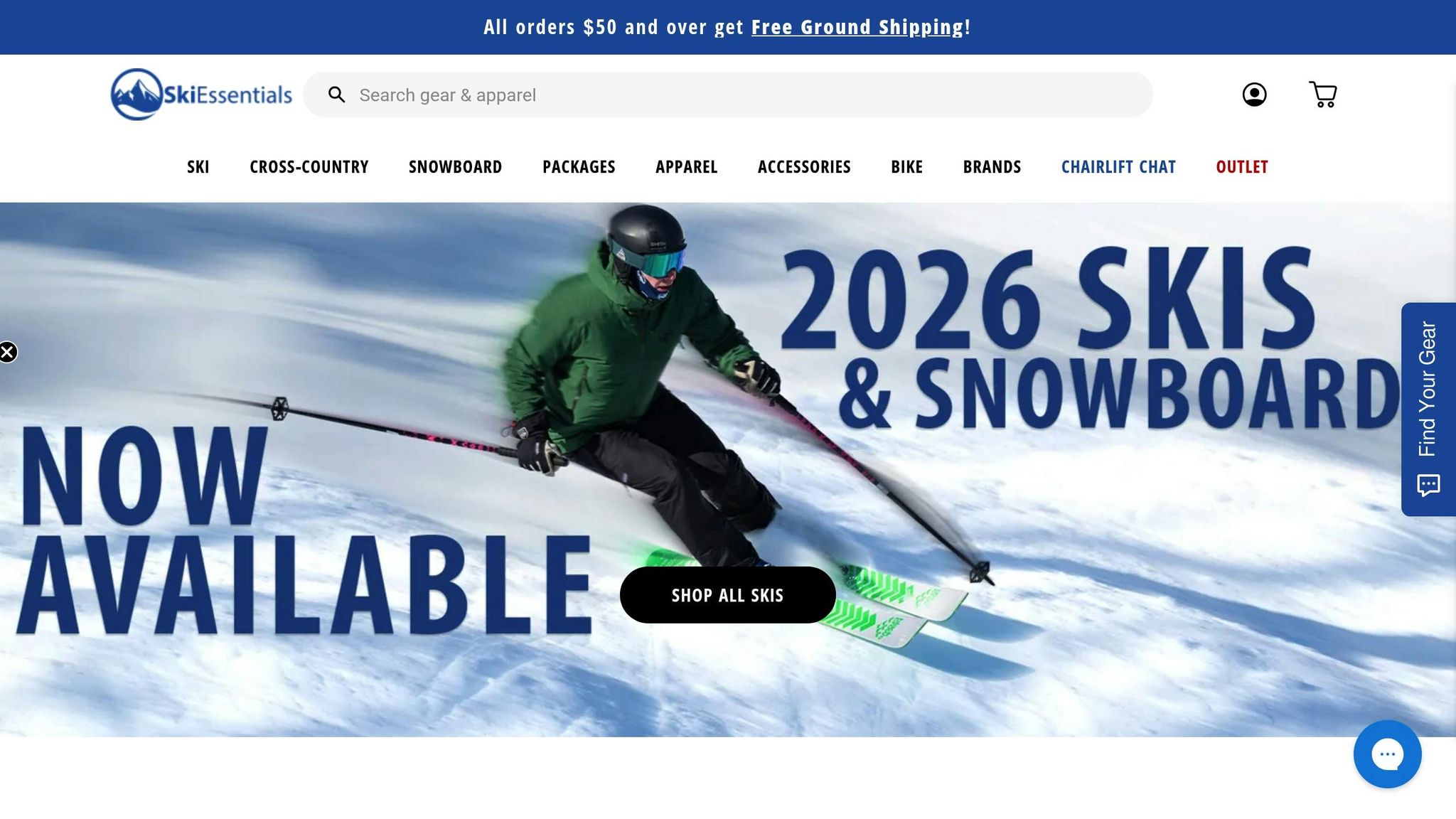
1. Snowfeet* WALKSKI Backcountry Touring Skis (100 cm)
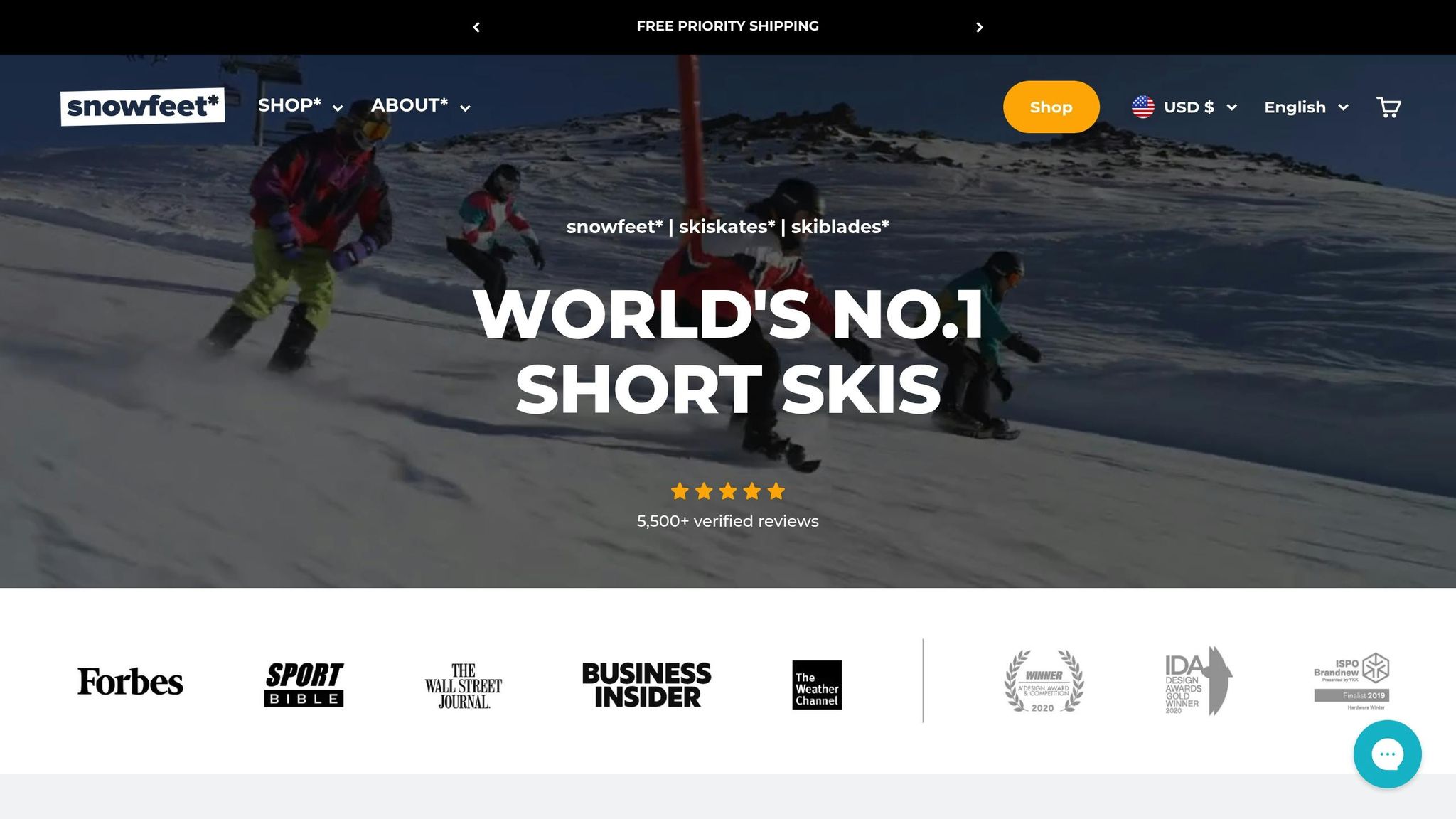
Snowfeet* WALKSKI Backcountry Touring Skis (100 cm) přinášejí svěží vítr do vybavení pro lyžování v divočině. S délkou pouhých 100 cm (39,4 palce) tyto lyže zpochybňují normu delších designů a dokazují, že kratší lyže mohou být velmi přenosné a obratné.
Hmotnost
Každý WALKSKI váží pouhých 2,6 lb (1,2 kg) - což je průlom oproti tradičním turistickým lyžím, které obvykle váží 5–7 lb každá. Tento lehký design znamená menší zátěž během dlouhých túr nebo přechodů a snadno se připínají na batoh. Ať už jdete na odlehlé místo pěšky nebo přecházíte mezi chůzí a lyžováním, tyto lyže pomáhají udržet únavu na uzdě.
Délka
Délka 100 cm dělá z těchto lyží sen pro navigaci v úzkých prostorech, jako jsou husté lesy nebo strmé stezky. Průvodci z Colorada chválí jejich rychlé přechody, zejména při přístupech k ledolezení nebo dosažení odlehlých chat. Když čelíte náročnému terénu v divočině, mít kompaktní, snadno ovladatelné lyže může znamenat zásadní rozdíl.
Kompatibilita s botami
Není třeba utrácet za specializované boty – tyto lyže fungují s běžnými zimními, turistickými nebo snowboardovými botami. Univerzální vázací systém podporuje velikosti US 6–14 a uživatele do 220 liber (100 kg). To znamená, že můžete vyrazit do backcountry bez nutnosti investovat do kompletní sady specializovaného lyžařského vybavení.
Použití v terénu
WALKSKI vyniká na zvlněném terénu, lesních stezkách a mírných svazích. Je ideální pro krátké přístupy a zpevněný sníh, což z něj dělá vynikající volbu pro ledolezecké výpravy, zimní túry nebo dobrodružství z chaty na chatu. Na rozdíl od tradičních dlouhých lyží nepředstavují problém v úzkých nebo nerovných podmínkách.
Cena
S cenou 299–349 USD nabízí WALKSKI cenově dostupnou alternativu k tradičním touringovým lyžím, které často stojí 600–1 000 USD a více. Přidejte k tomu kompatibilitu s běžnou zimní obuví a solidní hodnocení 4,5/5 hvězdiček z více než 200 recenzí a je jasné, že tyto lyže excelují v přenositelnosti, snadném použití a univerzálnosti.
Dále se podíváme, jak si vedou další špičkové modely.
2. Blizzard Zero G 105
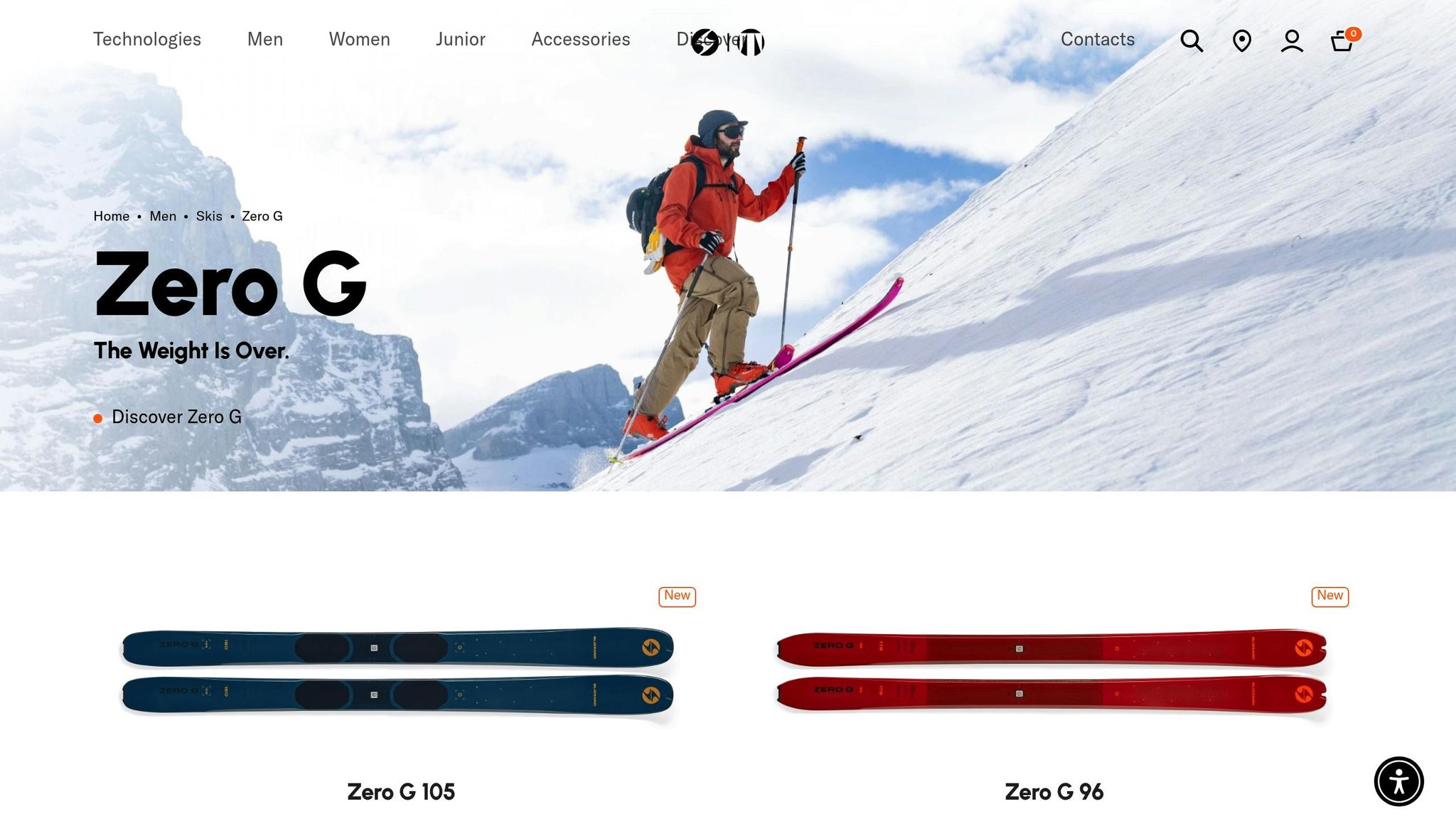
Blizzard Zero G 105 vyniká v hlubokém prašanu a na tvrdých svazích. Ať už kloužete měkkým sněhem nebo zdoláváte strmý terén, tato lyže nabízí spolehlivý výkon. Její design však přináší určité kompromisy – skvěle funguje na proměnlivém sněhu, ale může působit méně obratně na úzkých a technických úsecích.
Stabilita této lyže při vysokých rychlostech je jednou z jejích nejsilnějších stránek, ale stejná stabilita může způsobit, že působí méně obratně v místech, kde jsou potřeba rychlé a přesné pohyby. Pro rekreační lyžaře, kteří preferují mix terénů a pohodovou jízdu, může Zero G 105 působit příliš specializovaně. Je navržena pro ty, kdo rádi posouvají hranice, ne pro pohodové backcountry výlety.
Naopak Snowfeet* WALKSKI zvolil zcela odlišný přístup. Zaměřuje se na lehkost a jednoduchost, obětuje vysokorychlostní stabilitu pro snadné použití. To z něj dělá skvělou volbu pro lyžaře, kteří chtějí objevovat backcountry traily bez složitostí specializovaného vybavení.
3. Black Diamond Helio Carbon 95
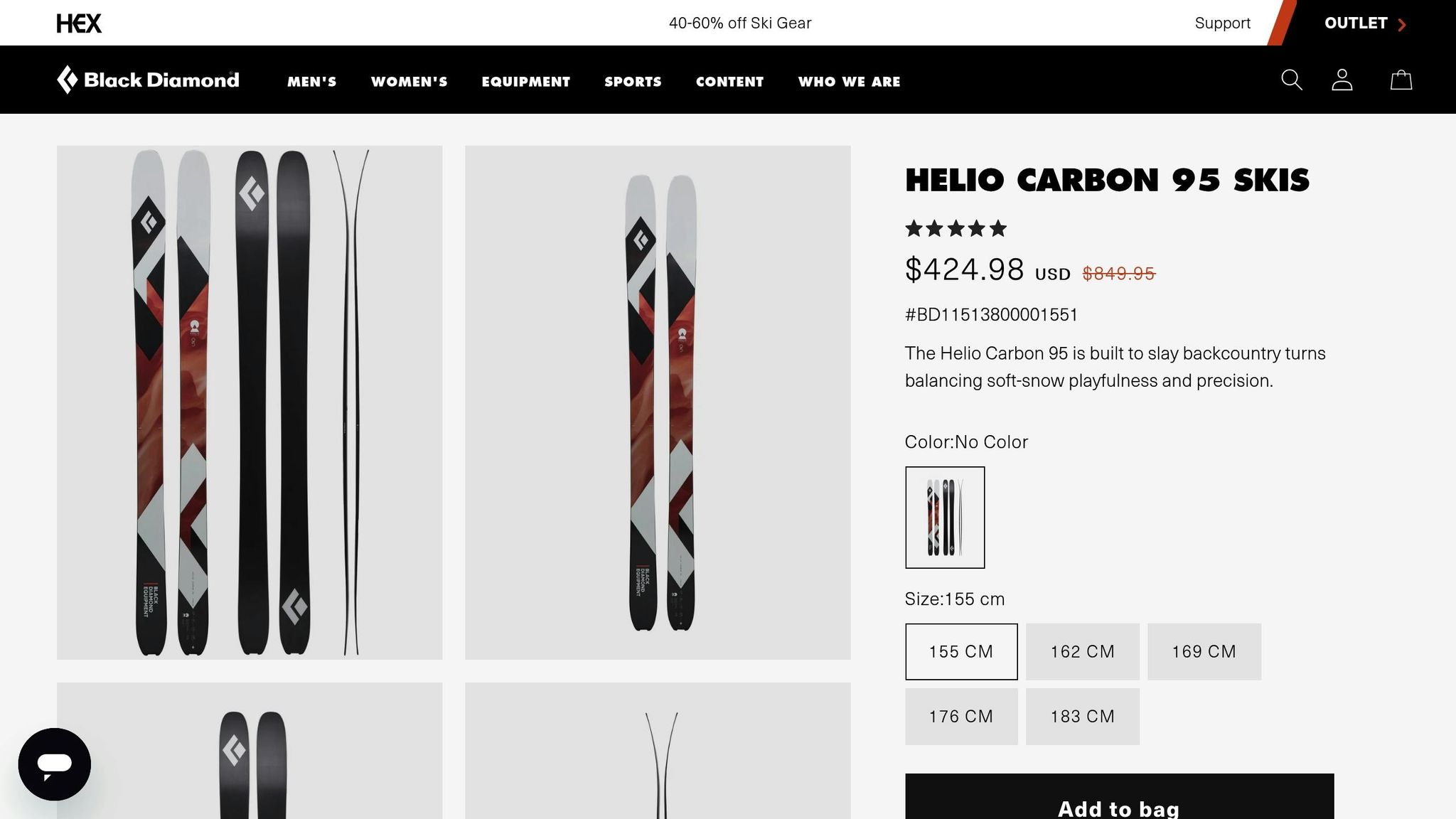
Black Diamond Helio Carbon 95 je klasickou volbou pro backcountry touring, která nabízí špičkový výkon. Jeho tradiční design však může působit trochu složitě, pokud hledáte něco jednoduššího, jako je elegantní Snowfeet* WALKSKI.
Hmotnost
Díky karbonové konstrukci Helio Carbon 95 ztrácí na váze oproti starším modelům. Přesto je ale stále těžší než moderní ultralehké možnosti jako Snowfeet* WALKSKI. Při dlouhých stoupáních vás ta extra váha může unavit, zatímco pírkově lehký design WALKSKI udržuje vše bez námahy.
Délka
Delší lyže jako Helio Carbon 95 musí být přizpůsobeny vaší výšce a postavě, což může ztížit jejich ovládání, zejména na úzkých místech. Na druhou stranu, kompaktní Snowfeet* WALKSKI tyto potíže zcela eliminuje. Jeho kratší velikost usnadňuje manipulaci, skladování i přepravu – a to vše bez kompromisů v univerzálnosti pro jízdu mimo sjezdovky.
Kompatibilita s botami
Tradiční skialpové lyže, jako Helio Carbon 95, vyžadují specifické boty a vázání, což může zkomplikovat (a prodražit) vaši výbavu. Naproti tomu Snowfeet* WALKSKI fungují se standardními zimními botami. To nejen zjednodušuje proces, ale také umožňuje použít vybavení, které pravděpodobně už máte.
Použití v terénu
Helio Carbon 95 exceluje v prudkém, technickém alpském terénu, nabízí přesnou kontrolu a agresivní výkon. Tato intenzita ale může být pro rekreační lyžaře příliš. Snowfeet* WALKSKI je naopak o zábavě a objevování. Je perfektní na mírné terénní traily a pohodovější dobrodružství.
Cena
Investice do Helio Carbon 95 znamená nejen lyže, ale i speciální boty a vázání – což je pořádná částka. Snowfeet* WALKSKI je však mnohem cenově dostupnější varianta. Nabízí vše v jednom řešení, ideální pro lyžaře, kteří chtějí snadný a levný vstup do skialpu.
sbb-itb-17ade95
4. K2 Wayback 106
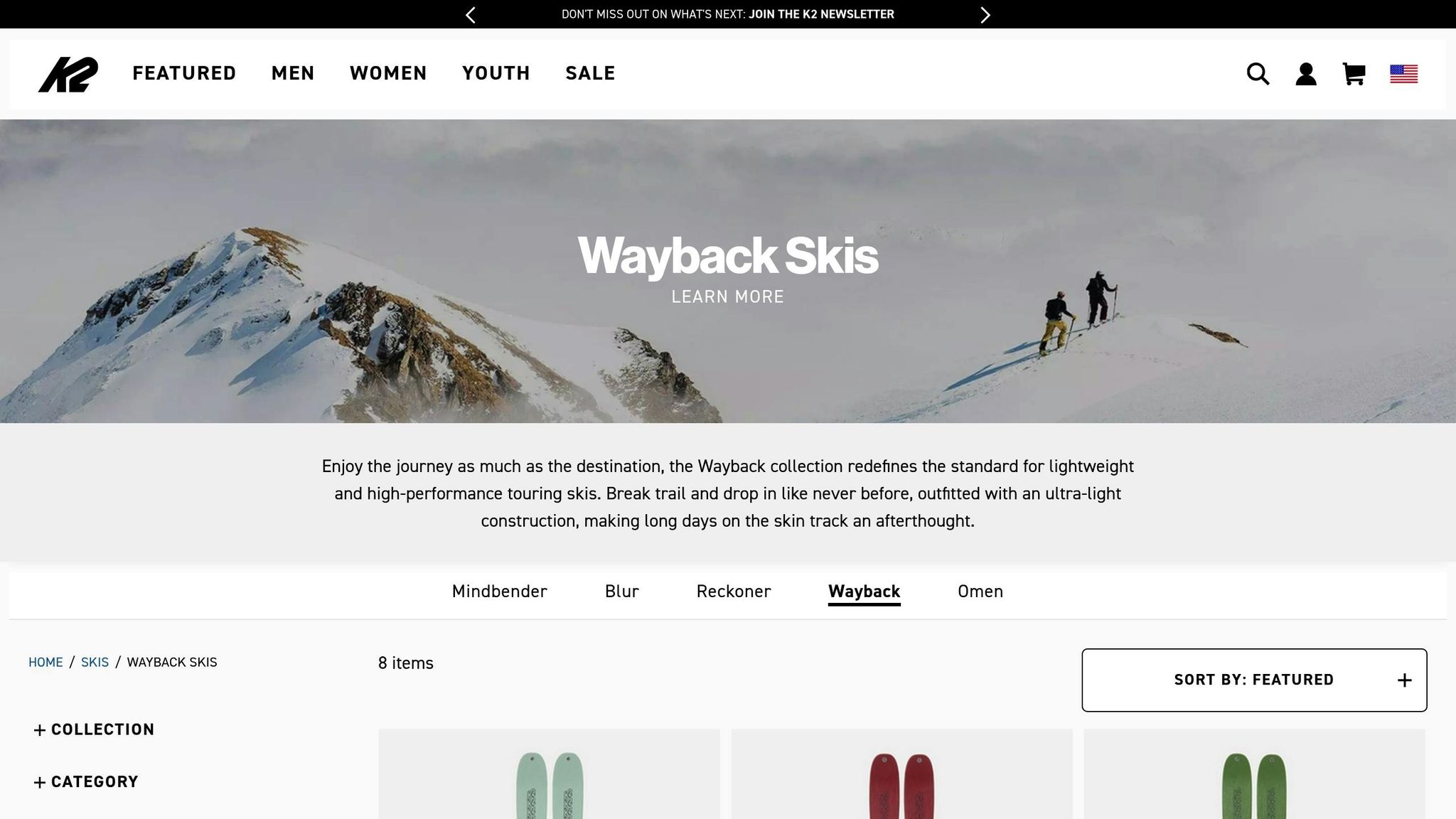
K2 Wayback 106 je spolehlivá volba pro tradiční skialp, ale přináší s sebou další kroky, které mohou být oproti jednoduchosti Snowfeet* WALKSKI otravné. Podívejme se na to zejména z hlediska kompatibility bot.
Kompatibilita s botami
U K2 Wayback 106 dostanete lyže bez předinstalovaných vázání. To znamená, že si musíte pořídit samostatná skialpová vázání a správně je namontovat. Navíc potřebujete boty kompatibilní s těmito vázáními – takže je tu trochu složitější příprava.
Na druhou stranu Snowfeet* WALKSKI vše zjednodušuje. Fungují s jakýmikoli standardními zimními nebo snowboardovými botami. Není potřeba žádné speciální vybavení ani složité uchycení. Je to vše v jednom řešení, které výrazně usnadňuje výpravy do terénu.
5. Salomon QST Echo 106
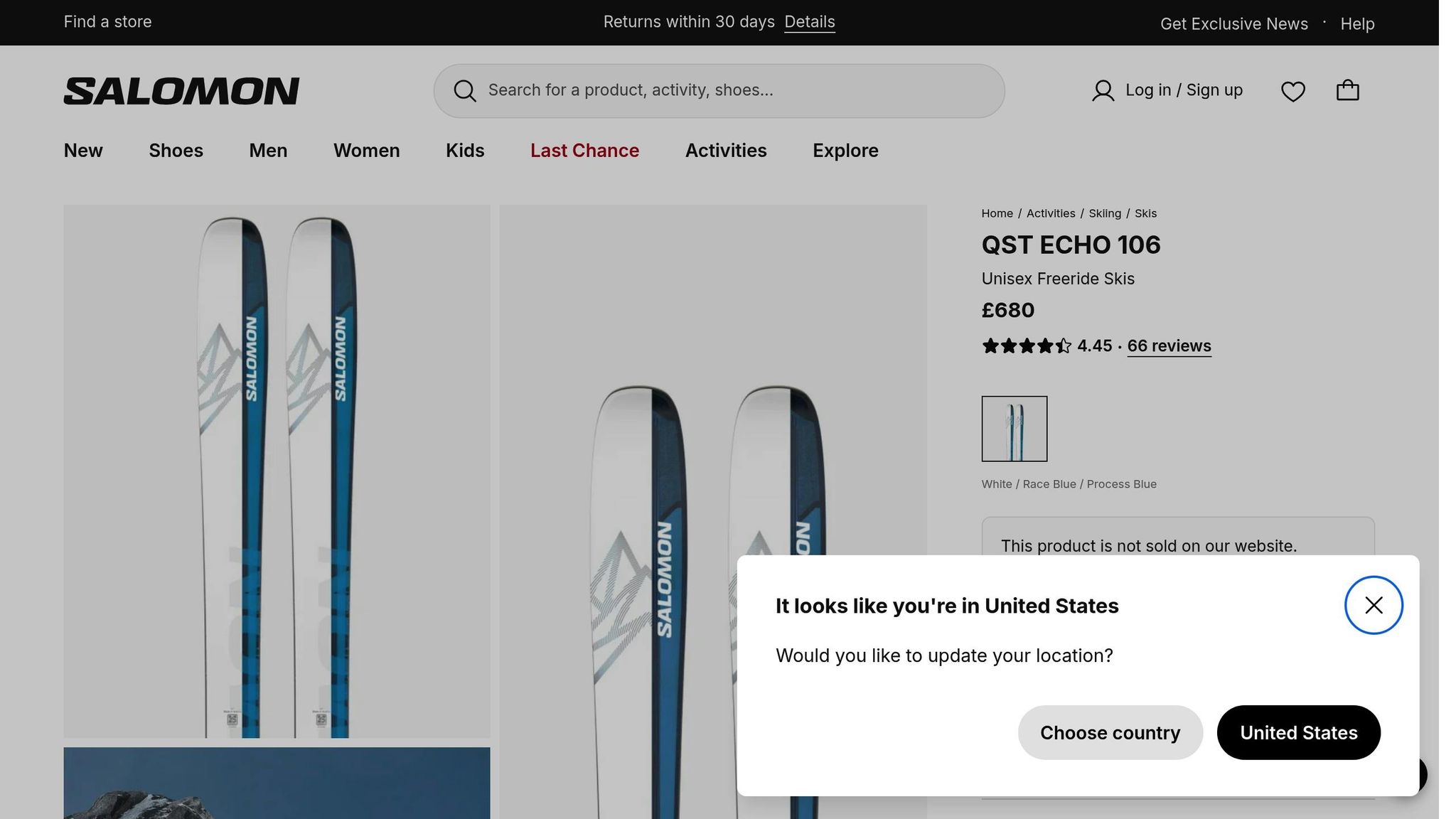
Pojďme se podívat blíže na Salomon QST Echo 106, klasickou skialpovou lyži, která ukazuje, proč může být jednodušší vybavení, jako Snowfeet* WALKSKI, často lepší volbou – zejména pro začátečníky v terénu nebo ty, kdo hledají snadnější a dostupnější variantu.
Hmotnost
QST Echo 106 je navržen jako lehká skialpová lyže, ale stále je těžší než Snowfeet* WALKSKI. Ta navíc váha může při výstupech unavovat, zvlášť na dlouhých túrách s výbavou. Naproti tomu lehčí Snowfeet* WALKSKI pomáhá šetřit energii, takže výstupy jsou o něco méně náročné.
Délka
U tradičních skialpových lyží, jako jsou QST Echo 106, je potřeba zvolit správnou délku podle vaší výšky, váhy a stylu jízdy. To může být pro nováčky výběr správné velikosti složitý. Snowfeet* WALKSKI tento problém zcela obchází díky designu "one-size-fits-most", který vyhovuje téměř všem dospělým, takže odpadá hádání.
Kompatibilita s botami
Zde je to ještě jednodušší. QST Echo 106 vyžaduje specializované boty a vázání pro alpské túry, které mohou být drahé a komplikovat vaši výbavu. Snowfeet* WALKSKI je naopak navržen tak, aby fungoval s vašimi stávajícími zimními botami – ať už jsou to turistické boty, snowboardové boty nebo zateplené zimní boty. Není potřeba drahé speciální vybavení ani profesionální montáž.
Použití v terénu
QST Echo 106 vyniká na upravených tratích a mírném terénu v přírodě, ale vyžaduje větší technické dovednosti k ovládání. Snowfeet* WALKSKI je však navržen s měkčí učební křivkou, což ho činí ideálním pro objevování nedotčeného sněhu a dosažení odlehlých míst bez náročného zvládnutí tradičních lyží. Tato snadnost použití z něj dělá vynikající volbu pro začátečníky v backcountry lyžování nebo kohokoli, kdo hledá bezproblémový zážitek.
Cena
Cena je další oblast, kde se tyto dvě možnosti výrazně liší. Kompletní sestava QST Echo 106 – která zahrnuje lyže, vázání a boty – může být velkou investicí. Naproti tomu Snowfeet* WALKSKI nabízí cenově dostupnou alternativu, která vám umožní vyrazit do přírody, aniž byste museli utrácet majlant nebo kupovat další vybavení. Je to výhra pro vaši peněženku i vaše dobrodružné plány.
Porovnání výhod a nevýhod
Zde je rychlý přehled klíčových vlastností každého modelu lyží vedle sebe, který vám pomůže zvážit vaše možnosti.
| Model lyží | Hmotnost | Délkové možnosti | Kompatibilita s botami | Použití v terénu | Cenové rozpětí |
|---|---|---|---|---|---|
| Snowfeet WALKSKI | Peříčko | Jedna velikost pro většinu (přibližně 100 cm / 39 palců) | Funguje s jakoukoli zimní obuví | Všestranný terén; vhodný pro začátečníky | $150–$199 |
| Blizzard Zero G 105 | Střední hmotnost | Různé délky | Vyžadují se boty a vázání AT | Terén pro pokročilé a výše | $600–$800+ sestava |
| Black Diamond Helio Carbon 95 | Lehké na tradiční lyže | Různé délky | Vyžadují se boty a vázání AT | Pokročilý terén | $700–$900+ vybavení |
| K2 Wayback 106 | Střední hmotnost | Různé délky | Vyžadují se boty a vázání AT | Středně pokročilý terén | $500–$700+ vybavení |
| Salomon QST Echo 106 | Lehké na tradiční lyže | Různé délky | Vyžadují se boty a vázání AT | Středně náročný backcountry terén | $550–$750+ vybavení |
Kde Snowfeet WALKSKI vyniká
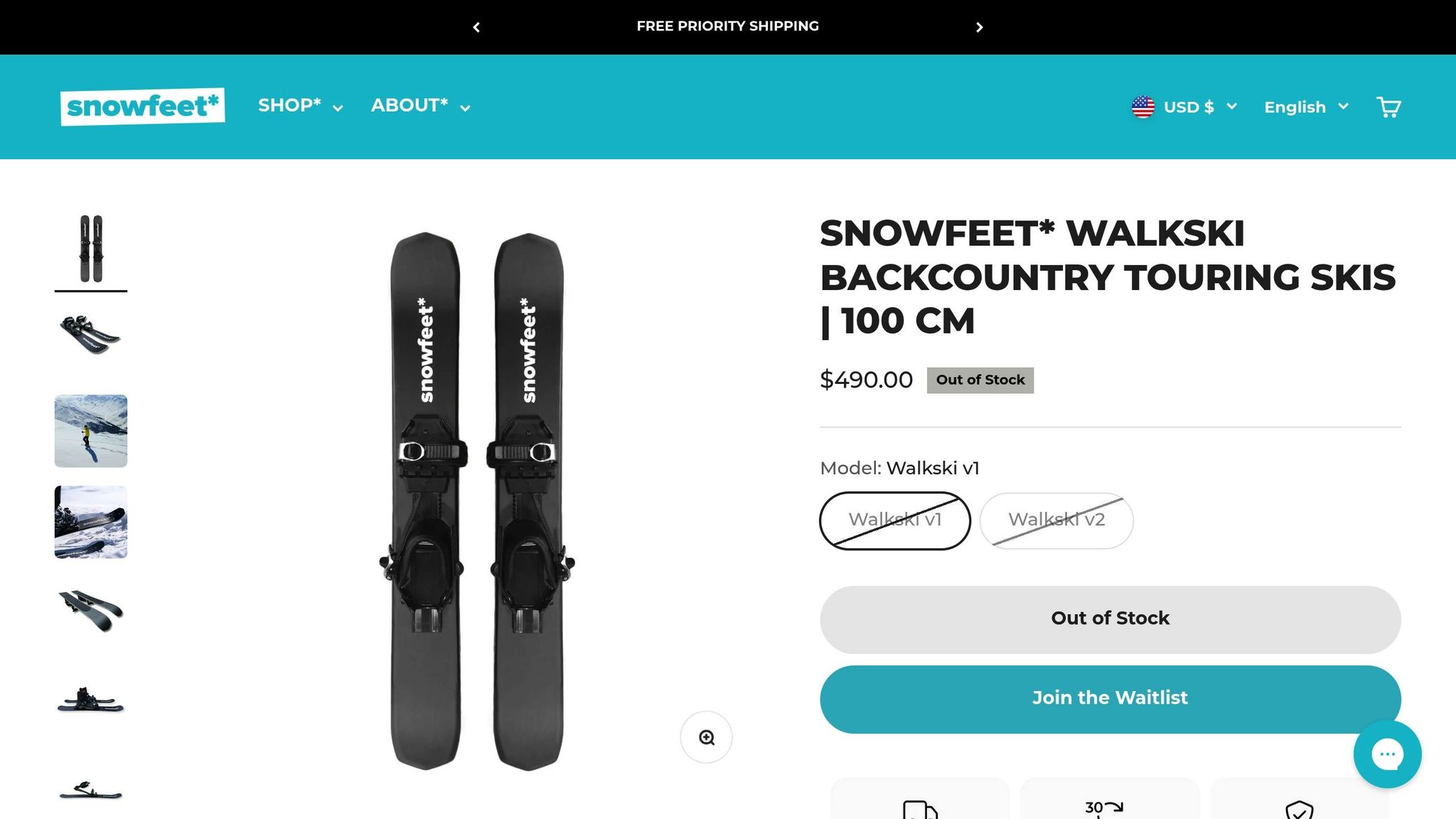
Snowfeet WALKSKI má jasnou výhodu, pokud jde o cenovou dostupnost. Tradiční lyžařské vybavení – zahrnující lyže, vázání a specializované boty – může snadno stát mezi 1 200 a 1 500 dolary. Naproti tomu WALKSKI vás dostane na sníh za méně než 200 dolarů.
Další výhoda? Jednoduchost. Tradiční lyže často vyžadují zvládnutí složitých vázacích systémů a technik, což může trvat měsíce. WALKSKI tohle všechno vynechává a nabízí snadno použitelnou možnost, která je perfektní pro rekreační lyžaře nebo ty, kteří si chtějí jen vyzkoušet dobrodružství v backcountry.
Přenosnost je další velkou výhodou WALKSKI. S délkou pouhých 39 palců (asi 100 cm) jsou dostatečně kompaktní, aby se vešly do kufrů aut, do horních přihrádek v letadlech nebo dokonce do velkého batohu. To srovnejte s tradičními lyžemi, které mají obvykle kolem 67 palců a vyžadují speciální přepravní vybavení.
Kde tradiční lyže vynikají
Tradiční lyže dominují v hlubokém prašanu. Jejich delší délka a širší plocha poskytují lepší vztlak, což je ideální pro čerstvý, nedotčený sníh a strmé, technické terény. Také nabízejí větší rychlost a stabilitu na upravených tratích díky tužší konstrukci – i když tato vyšší výkonnost přichází s nevýhodou větší hmotnosti při výstupech do kopce.
Učební křivka: Jednoduché vs. specializované
U tradičních sestav je potřeba se učit. Vyžadují čas a praxi k zvládnutí technik potřebných pro lyžování v terénu. Na druhou stranu WALKSKI nabízí přístupnější možnost pro ty, kteří chtějí začít bez komplikací nebo strmé učební křivky. Je to skvělá volba pro každého, kdo chce objevovat bez nutnosti měsíčního tréninku nebo velkých výdajů.
Základní srovnání
Pro začátečníky nebo příležitostné průzkumníky je Snowfeet WALKSKI ideální volbou díky kombinaci dostupnosti, snadného použití a přenosnosti. Pokročilí lyžaři, zejména ti, kteří se vydávají do strmých nebo hlubokých prašanových terénů, mohou preferovat specializovaný výkon tradičních túrových lyží. Ale pro většinu dobrodruhů WALKSKI odstraňuje mnoho překážek - náklady, složitost a objem - které často přicházejí s lyžováním v terénu.
Nakonec volba závisí na tom, zda si ceníte jednoduchosti a pohodlí, nebo potřebujete vylepšený výkon tradičních lyží. Sledujte nás pro naše závěrečné doporučení!
Závěrečná doporučení
Vyberte si lyže podle toho, co potřebujete pro své dobrodružství v terénu.
Pro začátečníky a příležitostné dobrodruhy:
Snowfeet WALKSKI je fantastická volba. Pod 200 dolarů je to cenově dostupný způsob, jak se pustit do lyžování v terénu, aniž byste museli utrácet majlant. Nejlepší na tom? Můžete použít své běžné zimní boty - není potřeba drahé, specializované vybavení. Navíc je to super snadné se naučit, takže strávíte více času užíváním venku a méně času řešením složitého vybavení.
Pro středně pokročilé lyžaře:
Pokud máte nějaké zkušenosti a už vlastníte AT boty, WALKSKI je lehká a jednoduchá alternativa. Je mnohem snazší na ovládání než těžší možnosti jako K2 Wayback 106, které mohou být při výstupech objemné a mají mnohem vyšší cenovku.
Pro pokročilé lyžaře:
I zkušení lyžaři mohou najít WALKSKI lákavý. Jasně, vysoce výkonné lyže jako Black Diamond Helio Carbon 95 jsou skvělé pro strmé, technické terény. Ale WALKSKI nabízí vážné výhody: je lehčí pro dlouhé přístupy a obratnější v úzkých místech. Jeho všestrannost a snadné použití z něj dělají solidní volbu i pro zkušené dobrodruhy v terénu, kteří čelí náročným trasám.
Tradiční lyžování v terénu často přichází s vysokou cenou a hromadou vybavení, které vyžaduje čas a úsilí k zvládnutí. Snowfeet mění pravidla hry tím, že nabízí kompaktní, cenově dostupné lyže, které se snadno přenášejí a jednoduše používají. To zpřístupňuje lyžování v terénu více lidem - ať už jste rodina hledající zábavný den venku, student na rozpočet, nebo někdo, kdo je jen zvědavý vyzkoušet něco nového.
Pokud nesměřujete za hlubokým prašanem nebo vysokorychlostními sjezdy na upravených tratích, Snowfeet WALKSKI pokrývají téměř vše, co většina backcountry lyžařů potřebuje. Díky eliminaci vysokých nákladů, složitosti a objemu otevírají dveře backcountry objevování mnohem širšímu okruhu lidí. Pro rok 2025 jsou to top volba pro každého, kdo je připraven vyrazit na lehký touring bez obvyklých komplikací.
Často kladené otázky
Proč jsou Snowfeet WALKSKI lepší volbou pro začátečníky než tradiční backcountry lyže?
Snowfeet WALKSKI jsou skvělou volbou pro začátečníky, a tady je proč: jejich kompaktní a lehká konstrukce je mnohem snazší na ovládání než tradiční backcountry lyže. S délkou pouhých 100 cm se snadno přenášejí a rychle vás neunaví. Pro někoho nového ve sportu může být manipulace s těžkými, objemnými lyžemi únavná, ale tyto udržují věci jednoduché.
Navíc jsou jednoduchá a snadno použitelná. Na rozdíl od tradičních lyží od velkých značek jako Rossignol nebo Atomic – které často vyžadují více dovedností a doplňkového vybavení – Snowfeet WALKSKI jsou navrženy tak, aby byly přátelské k začátečníkům. Ať už zůstáváte na mírných trasách, nebo se vydáváte do smíšeného terénu, tyto lyže dělají backcountry lyžování méně zastrašujícím a mnohem zábavnějším.
Jak fungují vázání Snowfeet WALKSKI s různými typy a velikostmi bot, aby zajistily pohodlí a všestrannost?
Snowfeet WALKSKI jsou vybaveny univerzálními, nastavitelnými vázáními, která fungují s různými typy bot, jako jsou zimní, turistické, trekkingové, lyžařské a snowboardové boty. Tato vázání pasují na délky podrážek od 9,5" do 15" (24 cm až 38 cm), což zajišťuje pevné a bezpečné uchycení pro většinu obuvi. To znamená, že můžete vyrazit na backcountry trasy bez potřeby speciálních bot, což vaše lyžařské dobrodružství činí pohodlnější a bezstarostnější.
Jsou Snowfeet WALKSKI vhodné pro všechny typy backcountry terénu, nebo existují omezení ve srovnání s tradičními lyžemi?
Snowfeet WALKSKI jsou ideální pro lehký touring a vynikají na mírných backcountry terénech. Myslete na mírné svahy, zvlněné kopce nebo dobře zhutněný sníh. Díky kompaktní velikosti a lehké konstrukci jsou velmi snadno přenosné a skvělé pro rychlé výlety nebo kombinaci turistiky s lyžováním.
To znamená, že nejsou nejlepší volbou pro strmé, členité trasy nebo hluboký prašan, kde tradiční lyže nabízejí lepší stabilitu, kontrolu a plavání. Pokud hledáte přenosnou, snadno použitelnou možnost pro jednodušší backcountry dobrodružství, Snowfeet WALKSKI jsou skvělou volbou. Jen mějte na paměti, že nejsou navrženy pro náročnější terény.

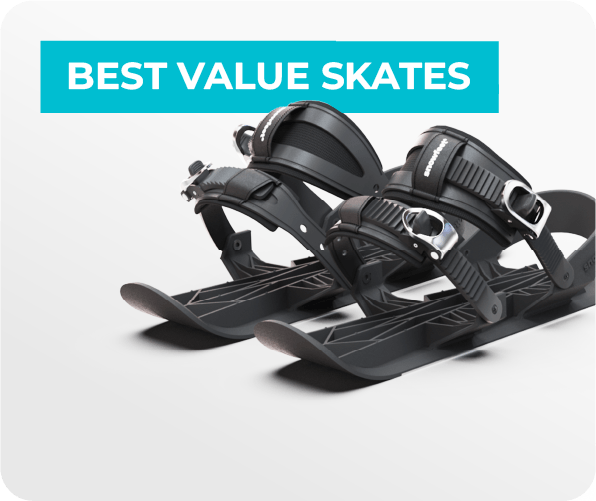



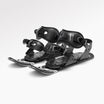
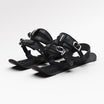
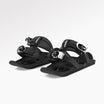
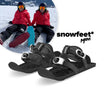

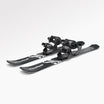

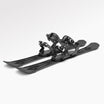
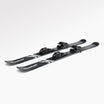






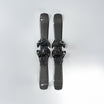
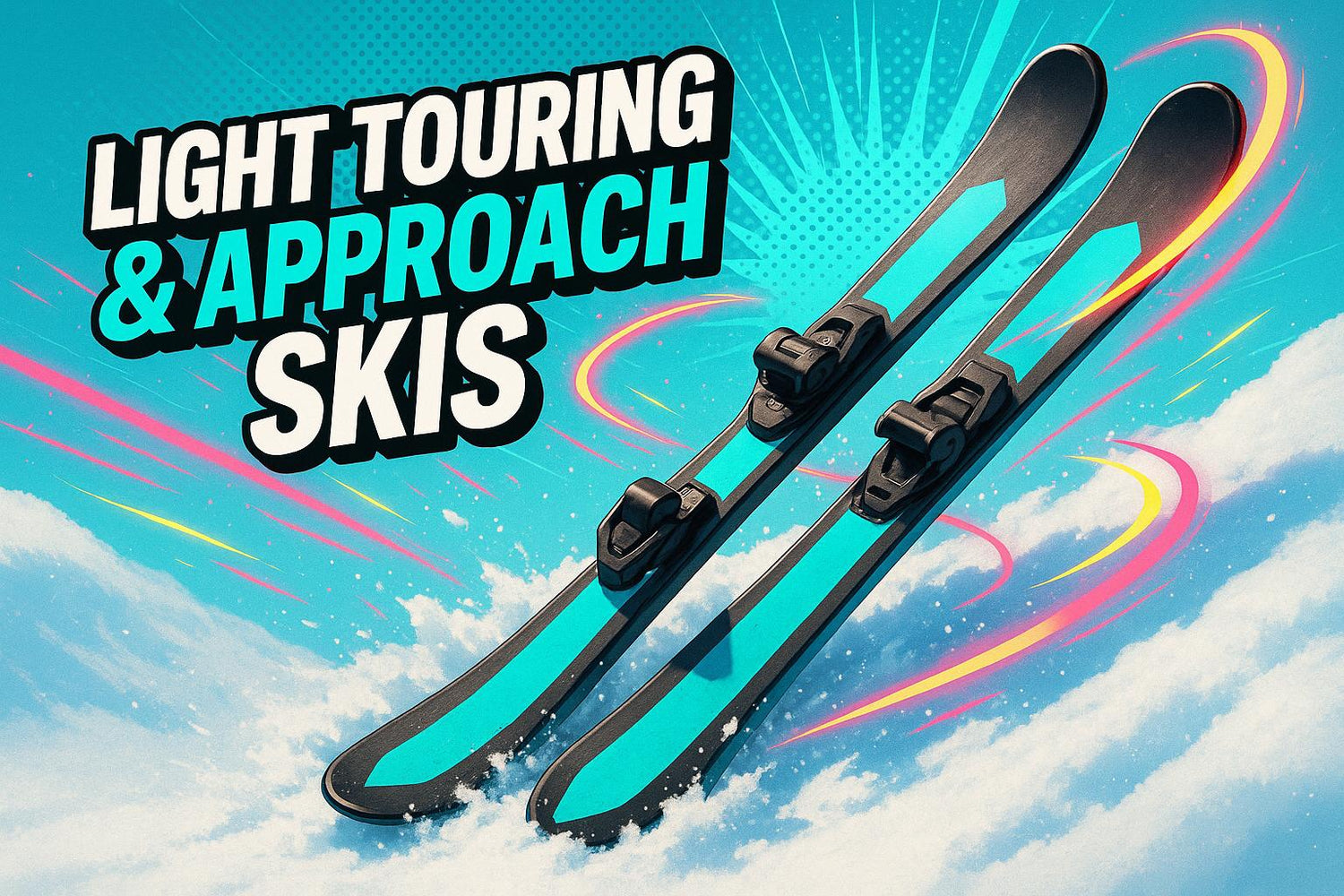

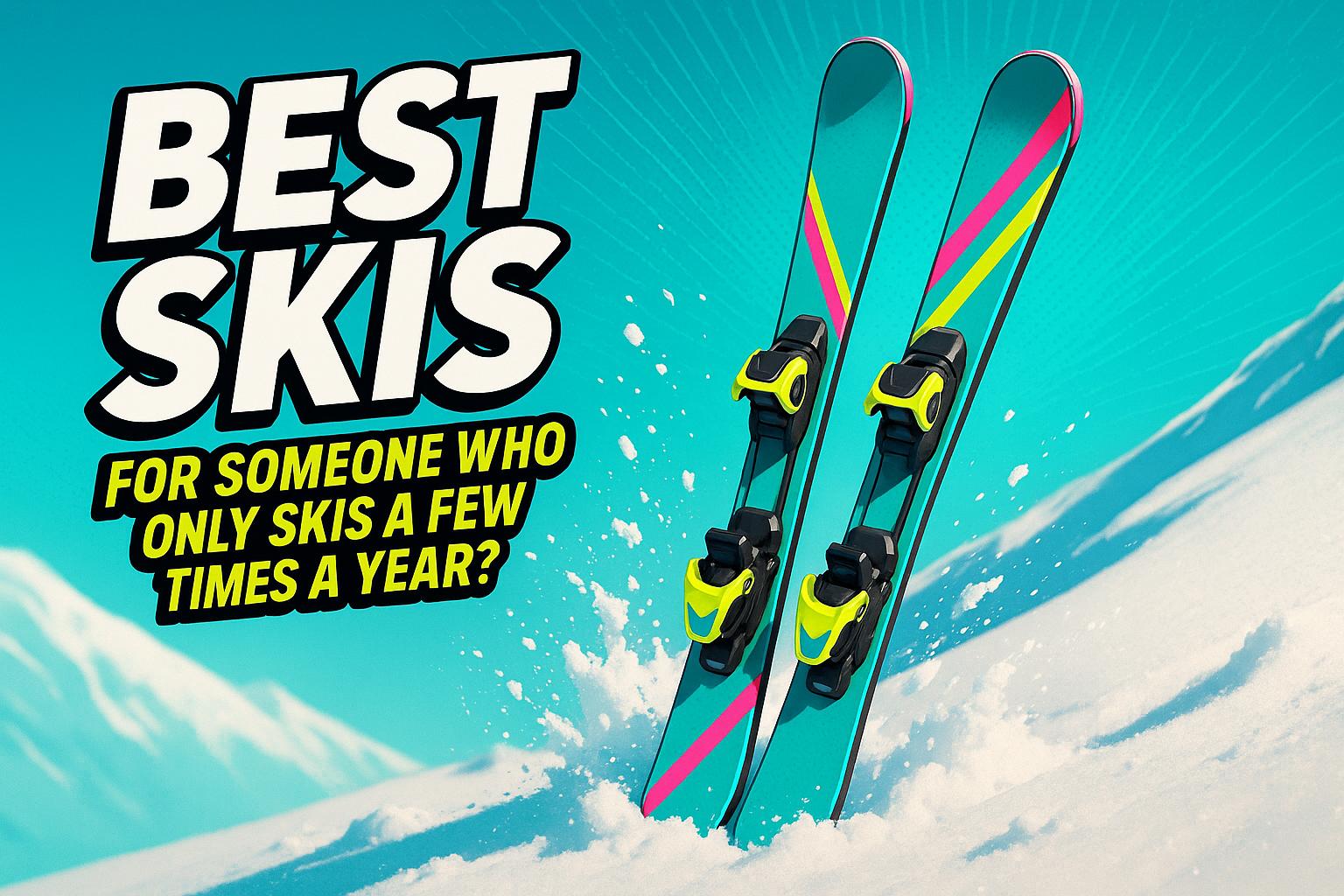
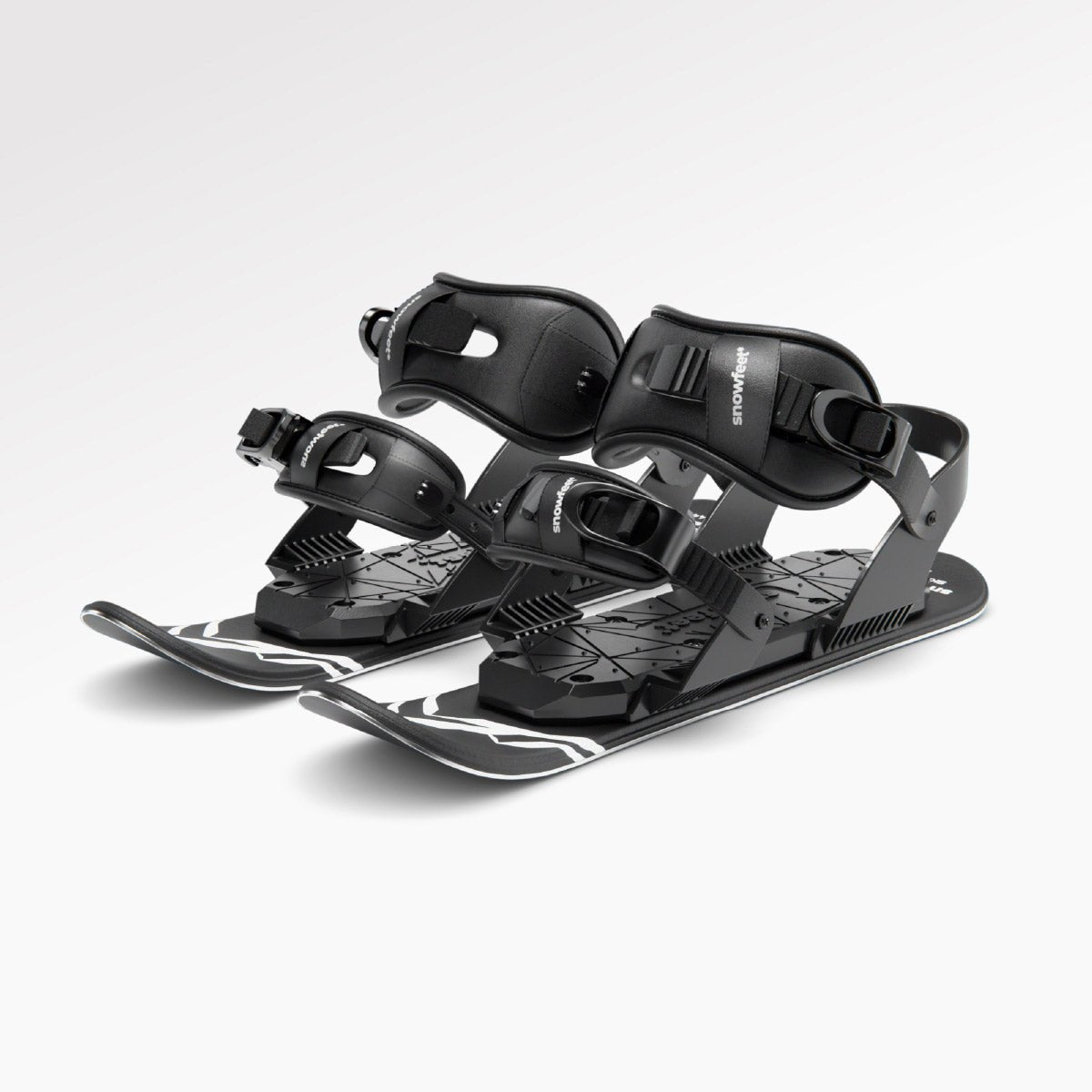
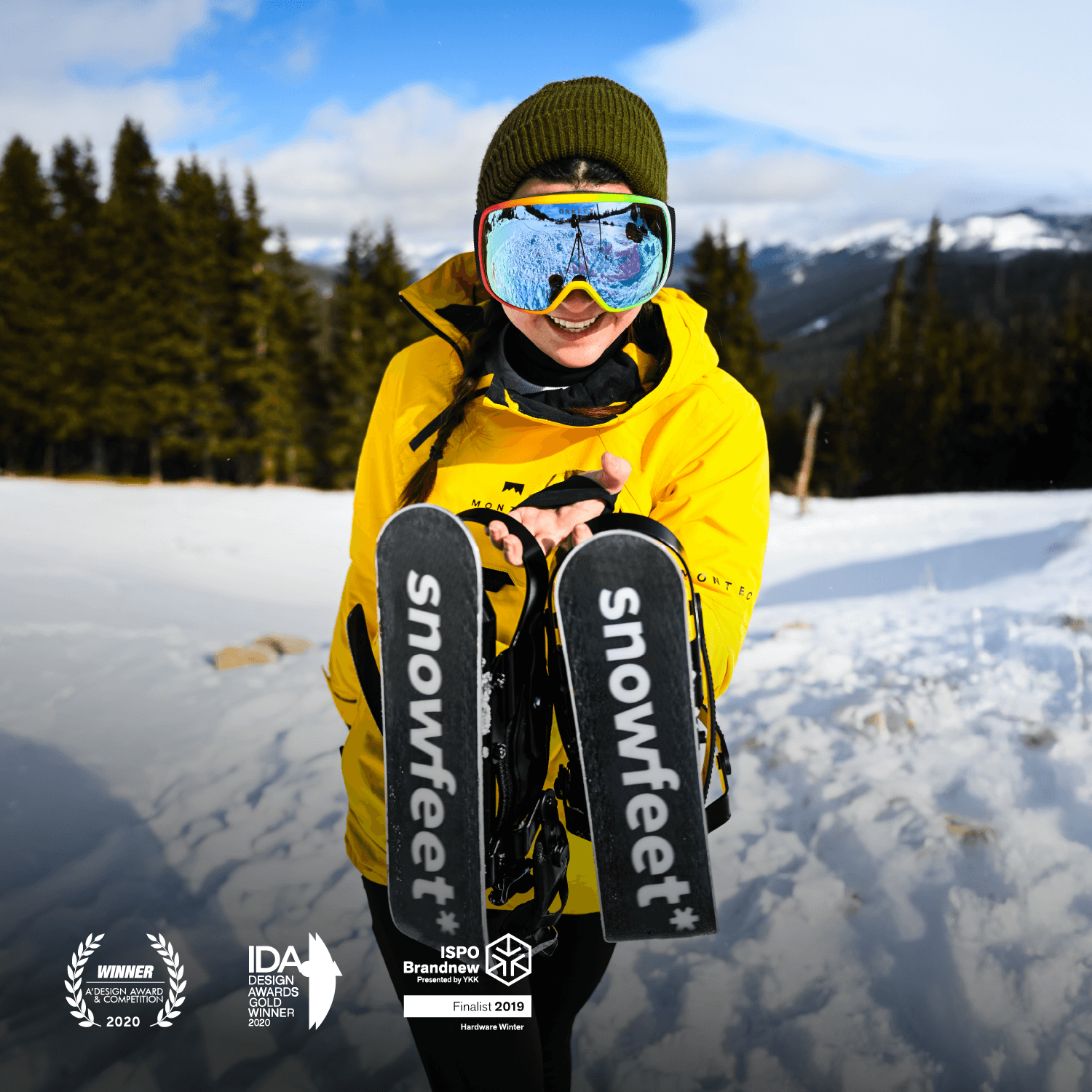
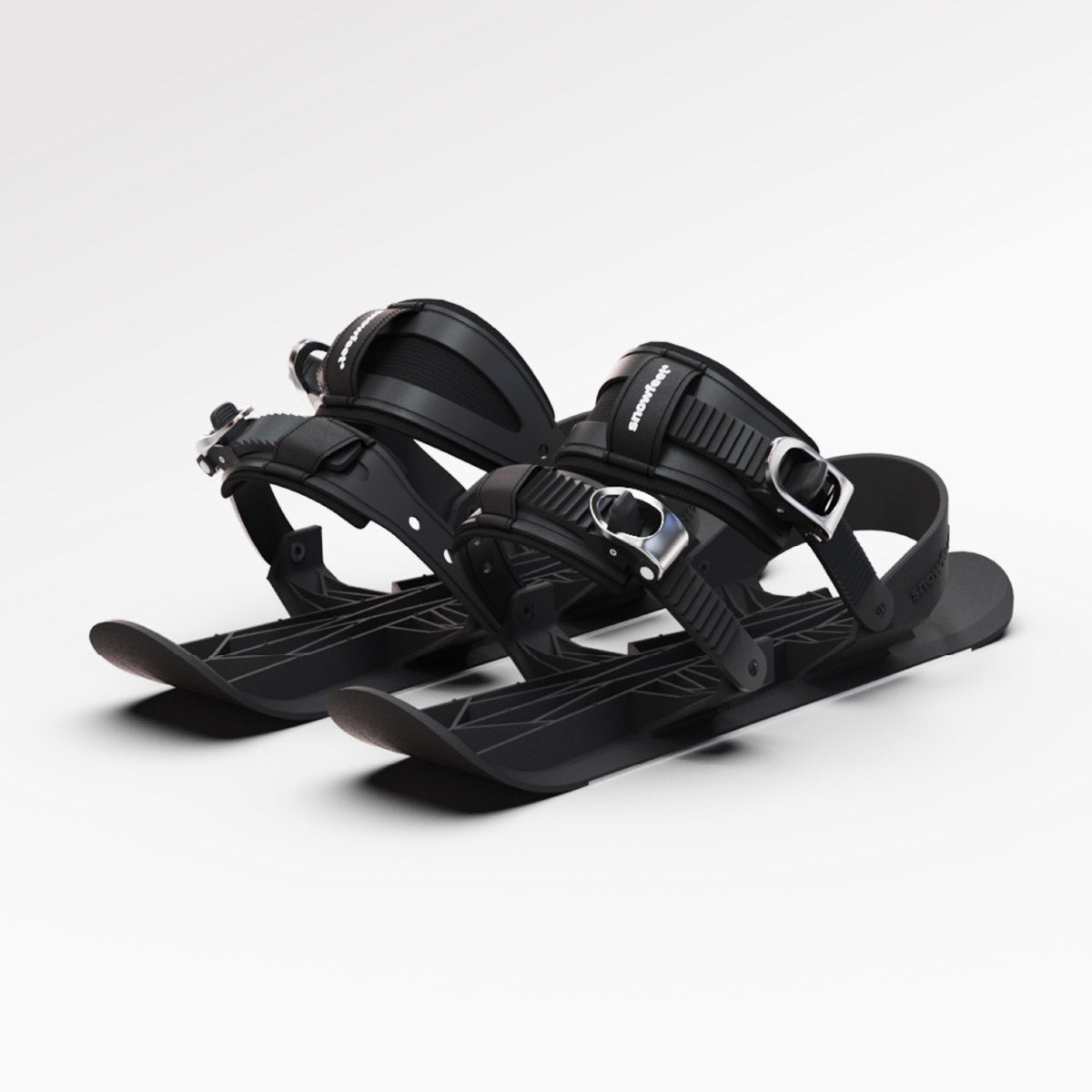

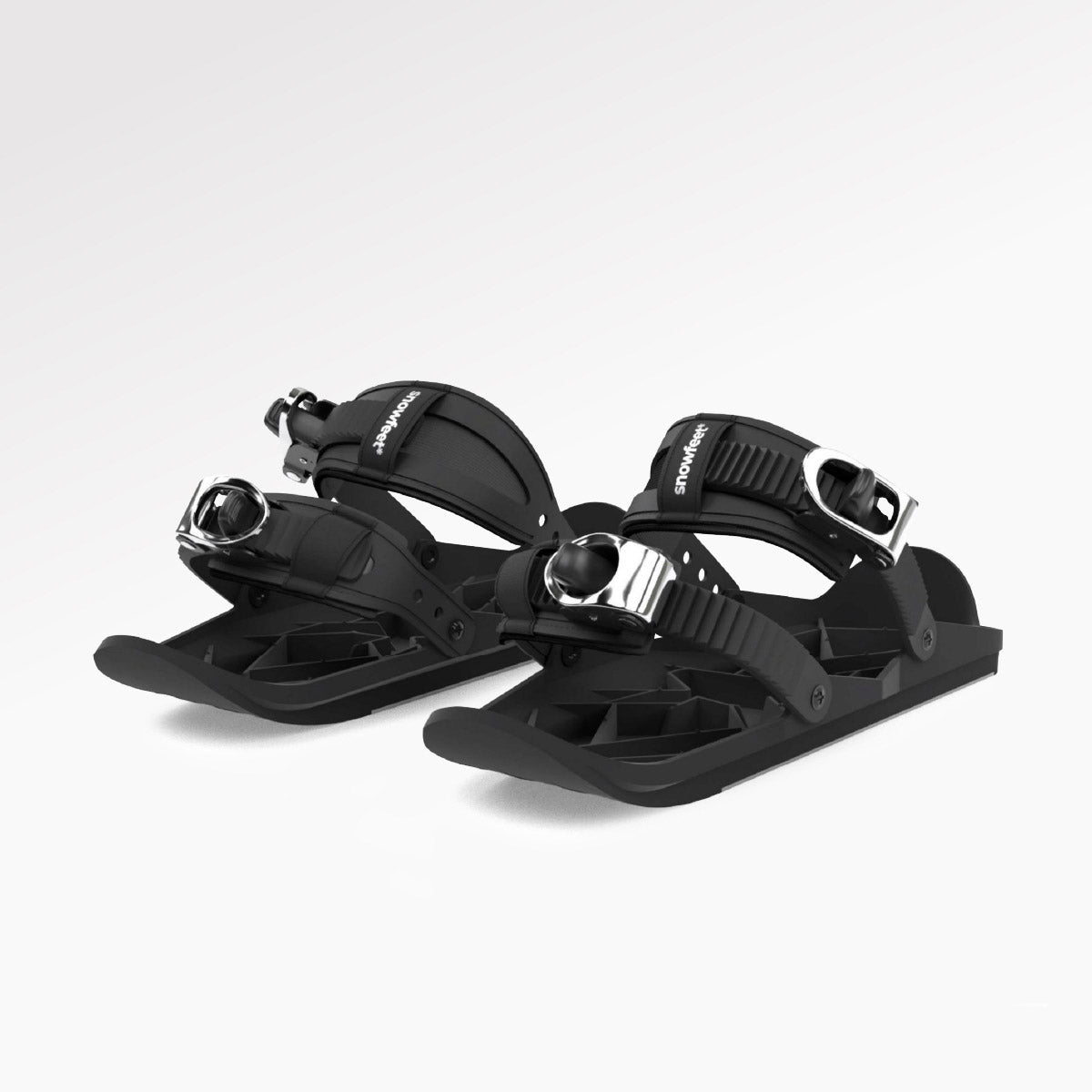
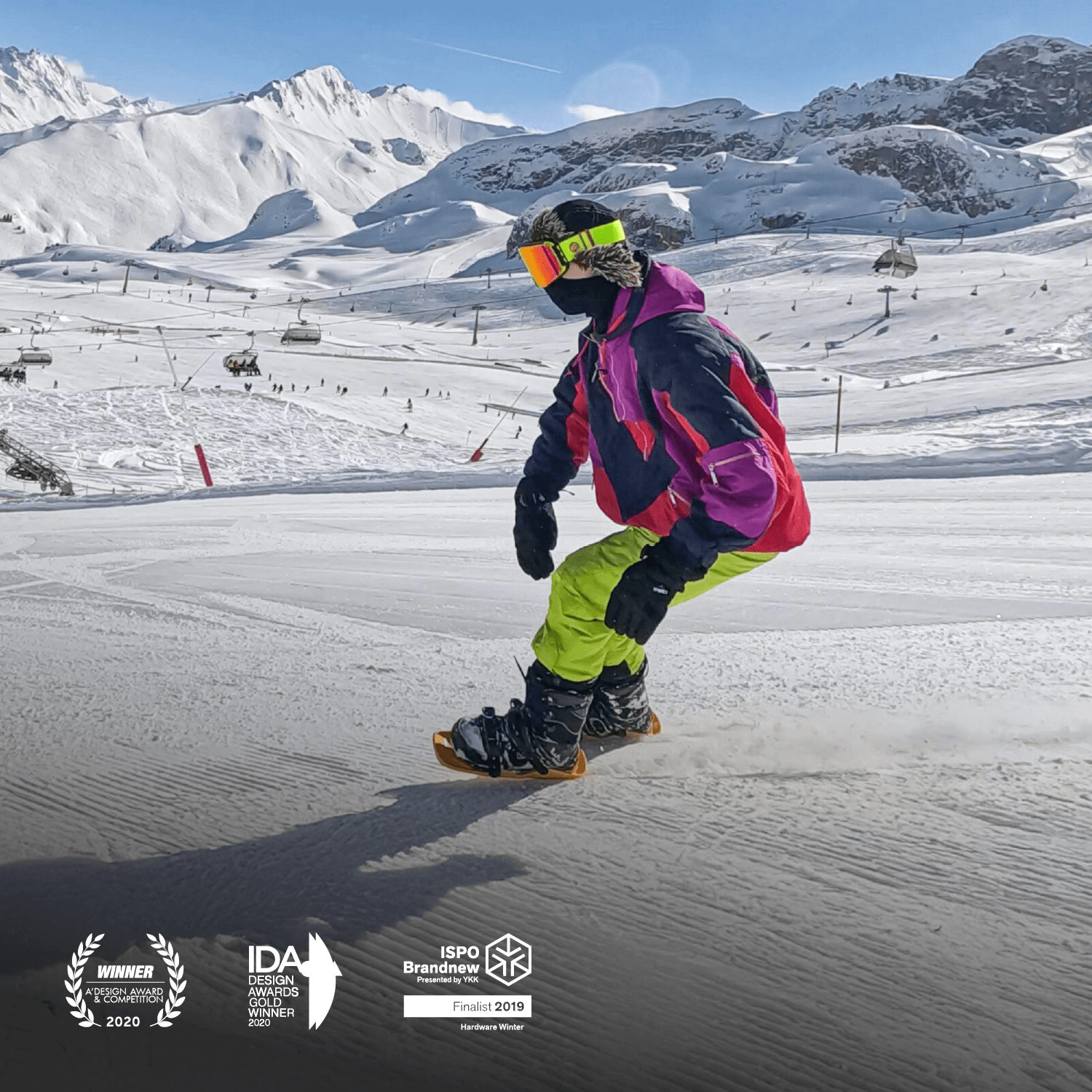


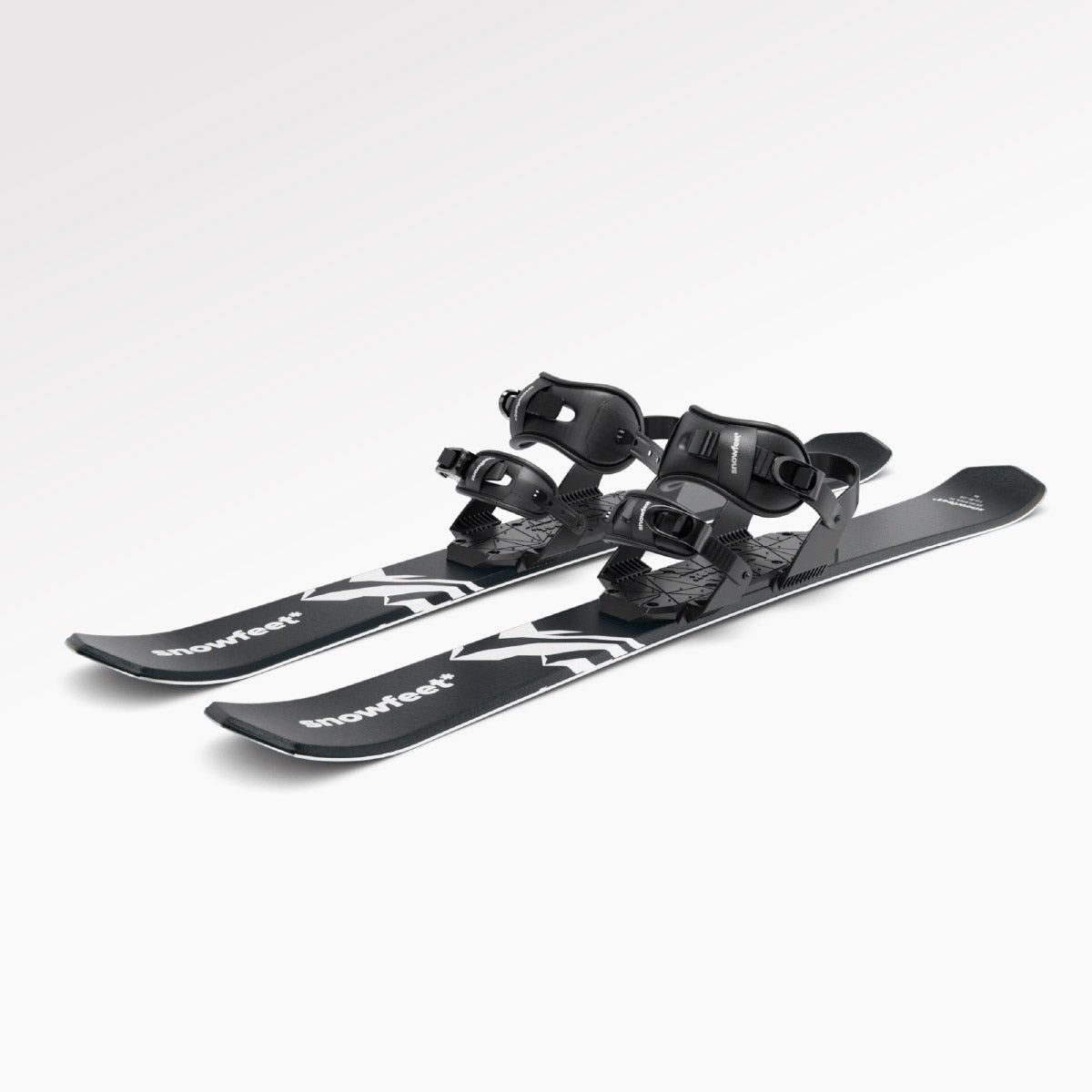
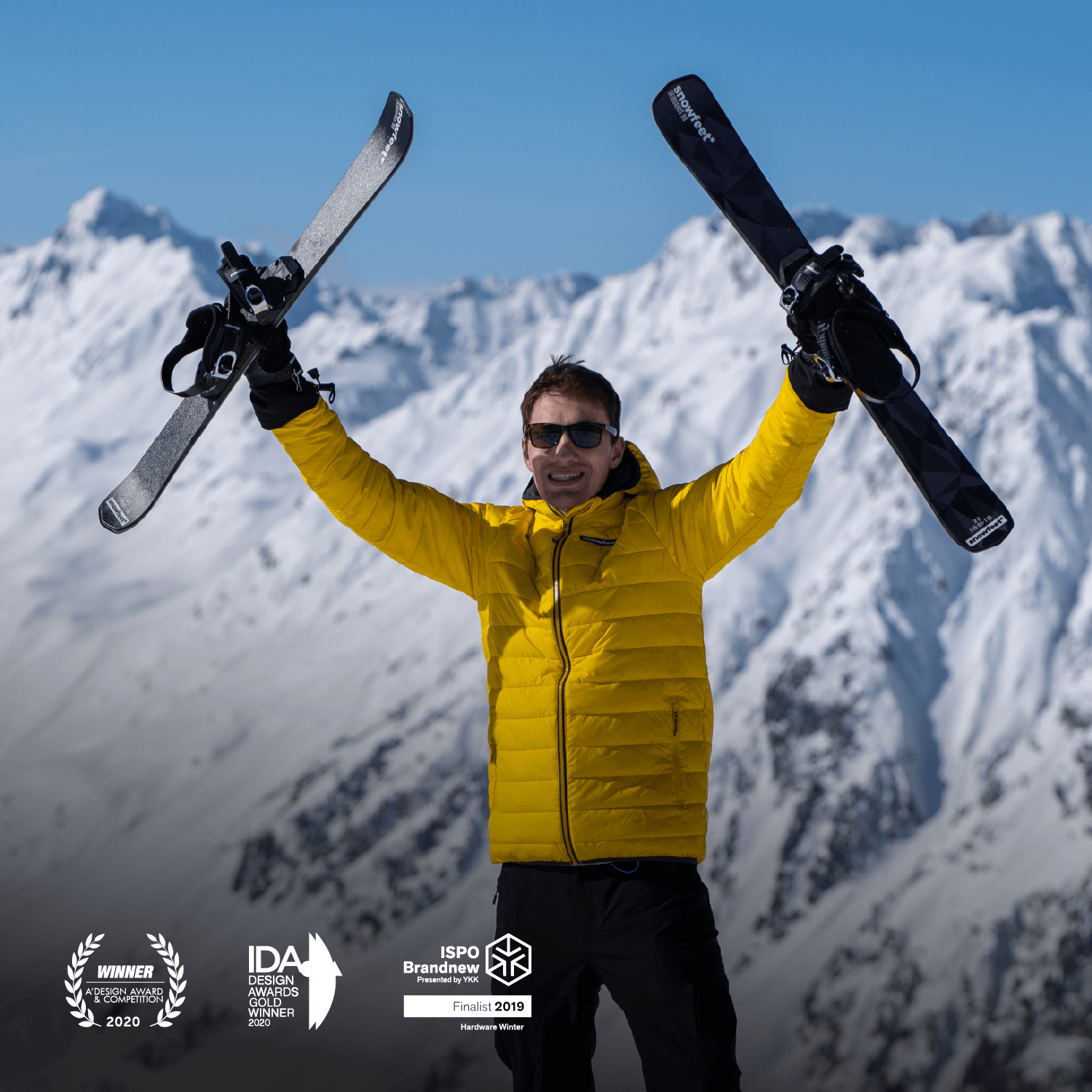
Zanechte komentář
Tento web je chráněn službou hCaptcha a vztahují se na něj Zásady ochrany osobních údajů a Podmínky služby společnosti hCaptcha.